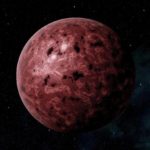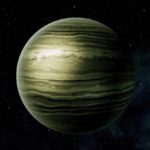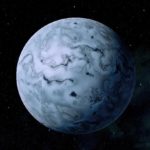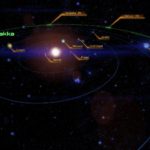System Specs:
- Stellar Mass: 1.00 Sol Masses
- Stellar Class: G
- Luminosity: N/A Sol
- Planets: 5
- Moons: 6
- Asteroid Belts: 0
- Asteroids: 0
- Objects: 2
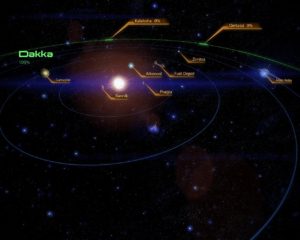
Dakka is a gateway system. Dakka may be named after a temple in ancient Egypt dedicated to the god Thoth. The planets themselves (save for Pragia) are named after different creatures from Slavic mythology.
–
Planets Directory:
- Bannik
- Pragia
- Alkonost
- fuel depot
- Gamayun
- Zirnitra
- Mass Relay
–
Bannik:
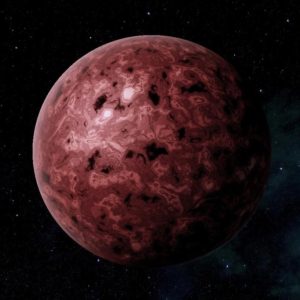
- Orbital Distance: 0.73 AU
- Orbital Period: 0.6 Earth-years
- Keplerian Ratio: 1.081
- Radius: 7,963 km
- Day Length: 54.8 Earth-hours
- Atmospheric Pressure: 65.4 atm
- Surface Temp: 599 °C
- Surface Gravity: 1.6 g
- Mass: 2.476 Earth-masses
Bannik is a large super-terrestrial “hothouse” with a crushing carbon dioxide atmosphere. A high average density of over seven grams per cubic centimeter indicates that Bannik is a mineralogical treasure trove. If only there were some way to safely reach its seas of molten metal and lodes of radioactives. The planet’s mass is so great that trace amounts of helium and molecular hydrogen can be found in the atmosphere.
–
Pragia:

- Orbital Distance: 1.3 AU
- Orbital Period: 1.5 Earth-years
- Keplerian Ratio: 0.976
- Radius: 5,137 km
- Day Length: 29.6 Earth-hours
- Atmospheric Pressure: 0.84 atm
- Surface Temp: 54 °C
- Surface Gravity: 0.87 g
- Mass: 0.56 Earth-masses
The jungle-planet Pragia is overrun by choking hyper-growth caused by industrially-mutated plant species. This, combined with its relative isolation and lack of population, has made Pragia an occasional base of operations for drug-runners, weapons-smugglers, pirates, mercenaries, terrorists, and intelligence agents seeking secrecy.
Sustained habitation on Pragia is extremely difficult, where mutant and even poisonous plant-life can overgrow colonies in days instead of years.
Codex Entry
Choked by the hyper-growth of non-native plant species, Pragia serves as a galactic reminder about the imperative for careful regulation during colonization.
Two centuries ago, batarian agribusiness chose uninhabited Pragia as their empire’s breadbasket. Colonization authorities introduced non-native, industrially-mutated plants that flourished in the world’s fertile volcanic soil. Synergizing with Pragia’s natural geothermal conditions and chemotropic microbes, the imported species soon became a nightmare. Mutant strains of poisonous and even carnivorous plants arose, overgrowing colonies in days instead of years, and causing the batarians to abandon their holdings. Because the planet’s small animal population is insufficient to check its plant growth, Alliance ecologists predict soil exhaustion in 400 years.
Due to its relative isolation and lack of population, Pragia has become a regional haven for drug-runners, weapons-smugglers, pirates, mercenaries, terrorists, and intelligence agents seeking secrecy.
–
Alkonost:
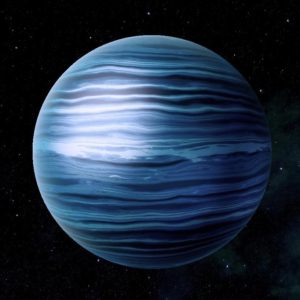
- Orbital Distance: 2.47 AU
- Orbital Period: 3.9 Earth-years
- Keplerian Ratio: 0.991
- Radius: 17,946 km
- Day Length: 18.8 Earth-hours
- Atmospheric Pressure: N/A atm
- Surface Temp: N/A °C
- Surface Gravity: N/A g
- Mass: N/A Earth-masses
Alkonost is a standard ice giant with a methane-ammonia atmosphere. It has an unusually strong magnetic field, which is occasionally useful when ships need to discharge their drives.
–
Gamayun:
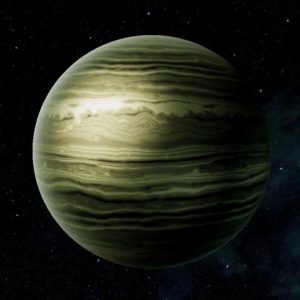
- Orbital Distance: 5.19 AU
- Orbital Period: 11.8 Earth-years
- Keplerian Ratio: 1.004
- Radius: 50,875 km
- Day Length: 65.6 Earth-hours
- Atmospheric Pressure: N/A atm
- Surface Temp: N/A °C
- Surface Gravity: N/A g
- Mass: N/A Earth-masses
- Satellites: 6
Gamayun is a hydrogen-helium gas giant with six large, icy moons. The outermost one, Gigula, is of note for a well-preserved wreckage of an ancient starship that was recovered by a turian military surveyor. Little information has been released to the public on the vessel, aside from a scholarly paper regarding how the internal layout suggests a horizontally-oriented race.
–
Zirnitra:

- Orbital Distance: 7.78 AU
- Orbital Period: 21.8 Earth-years
- Keplerian Ratio: 0.991
- Radius: 2,683 km
- Day Length: 44.9 Earth-hours
- Atmospheric Pressure: Trace atm
- Surface Temp: −158 °C
- Surface Gravity: 0.16 g
- Mass: 0.028 Earth-masses
Cold, distant Zirnitra has an extremely low density, and is thought to be mainly water ice around a small rocky core. It has little to recommend it.
–
–
video

